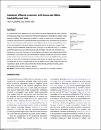Industrial effluent treatment with immersed MBRs: Treatability and cost
Abstract
A comprehensive OPEX analysis for both municipal and industrial wastewaters has been conducted encompassing energy, critical component (membrane) replacement, chemicals consumption, waste disposal and labour. The analysis was preceded by a review of recent data on industrial effluent treatability with reference to published chemical oxygen demand (COD) removal data for four effluent types: food and beverage, textile, petroleum and landfill leachate. Outcomes revealed labour costs to be the most significant of those considered, contributing 50% of the OPEX for a 10,000 m3/day capacity municipal wastewater treatment works. An analysis of the OPEX sensitivity to 12 individual parameters (labour cost, flux, electrical energy cost, membrane life, feed COD, membrane cost, membrane air-scour rate, chemicals cost, waste disposal cost, mixed liquor suspended solids (MLSS) concentration, recirculation ratio, and transmembrane pressure) revealed OPEX to be most sensitive to labour effort and/or costs for all scenarios considered other than a large (100,000 m3/day capacity) works, for which flux and electrical energy costs were found to be slightly more influential. It was concluded that for small- to medium-sized plants cost savings are best made through improving the robustness of plants to limit manual intervention necessitated by unforeseen events, such as electrical/mechanical failure, foaming or sludging. - IWA Publishing 2019.
Collections
- Chemical Engineering [1190 items ]


